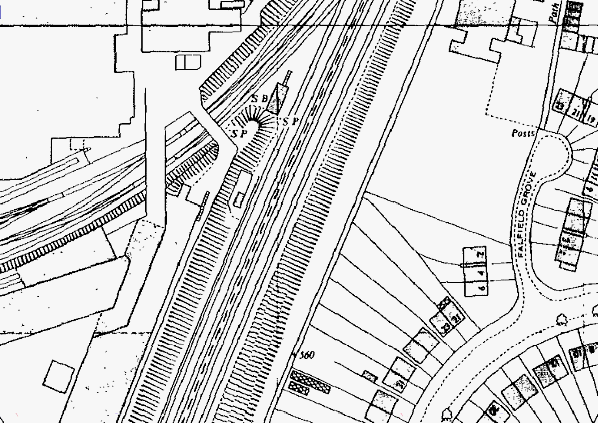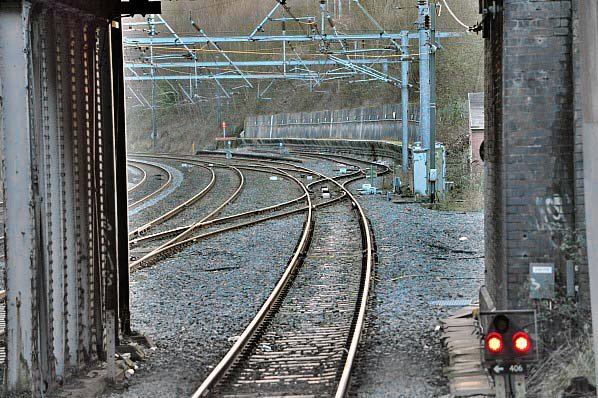
Station Name: LONGBRIDGE 3rd site[Source:
Terry Callaghan]
old9.jpg)
A MR 2F 1873 class 0-6-0 standing at the platform in June 1921 with a rake of surburban stock en route to Birmingham.
Photo by from the John Mann collection 
The 1965 OS plan at 1:1,2500 scale shows the site of the station after the 1930's quadrupling of the line. The bridge crossing the Halesowen branch to the left of the lower signal post (SP) was the access to and from the station for the part of the works on the opposite side of the Halesowen branch.
junction.jpg) Looking south towards Halesowen Junction signal box during August 1955 the station was located to the left of the signal box. The platform that can be seen to the rear of the signal box was a later addition following the quadrupling of the line and has not been listed as a passenger platform. Photo by D J Norton To see more of the D J Norton collection click here junction1.jpg) The 3rd signal box to control operations at Halesowen Junction was this Midland Railway type 4e box opened on 5 January 1930. The box survived the Saltley Power Box resignalling scheme in the area, being retained for movements along the Halesowen branch only. It was finally abolished on 4 November 1973 seen here during May 1959.
Photo by M A King junction3.jpg) Looking towards Birmingham at what would have been the end of the down platform during May 1959 the site is occupied by the right hand track, the down goods. Photo by M A King  The site of Halesowen Junction and the 3rd of Longbridge's stations on 17 January 2015 the trackbed of the branch can be seen diverging away directly under the bridge. The line deviating from the up slow is to allow Cross City line trains terminating at Longbridge to turn back. Photo by Terry Callaghan
 Home Page Home Page
|
 The third station at Longbridge was provided out of necessity to transport workers to the large First World War munitions factory that had been set up within the Austin Motor Works. The station opened on 1 July 1918 some five months prior to the cessation of the conflict. It comprised two substantial platforms on the double-track main line, 12 chains (264yd) south-west of Halesowen Junction with direct access to the factory complex. Little is known about provision of services to and from the station although no goods facilities were known to have been provided. The station platforms were lit by a substantial amount of lanterns. During the final months of the war the station was extremely busy with untimetabled services with 1000-or-more passengers using them. Patronage continued after the war and the MR continued serve the station, although trains were still not advertised. Passenger numbers began to dwindle as Austin’s was starting to recruit more people locally as suburban housing estates began to spring up in the once-rural area. It seems that the MR was still content to allow services to call even though passenger numbers were declining, although they made representation to the Austin Motor Company to have the shift times altered to fit in better with the timetable, a request that the company declined. With this the MR announced that they would be closing the station and, despite protests, most notably from the Mayor of Worcester who was concerned at the level of unemployment in his city, the protest had no effect and the station closed on 25 February 1922.
The third station at Longbridge was provided out of necessity to transport workers to the large First World War munitions factory that had been set up within the Austin Motor Works. The station opened on 1 July 1918 some five months prior to the cessation of the conflict. It comprised two substantial platforms on the double-track main line, 12 chains (264yd) south-west of Halesowen Junction with direct access to the factory complex. Little is known about provision of services to and from the station although no goods facilities were known to have been provided. The station platforms were lit by a substantial amount of lanterns. During the final months of the war the station was extremely busy with untimetabled services with 1000-or-more passengers using them. Patronage continued after the war and the MR continued serve the station, although trains were still not advertised. Passenger numbers began to dwindle as Austin’s was starting to recruit more people locally as suburban housing estates began to spring up in the once-rural area. It seems that the MR was still content to allow services to call even though passenger numbers were declining, although they made representation to the Austin Motor Company to have the shift times altered to fit in better with the timetable, a request that the company declined. With this the MR announced that they would be closing the station and, despite protests, most notably from the Mayor of Worcester who was concerned at the level of unemployment in his city, the protest had no effect and the station closed on 25 February 1922.